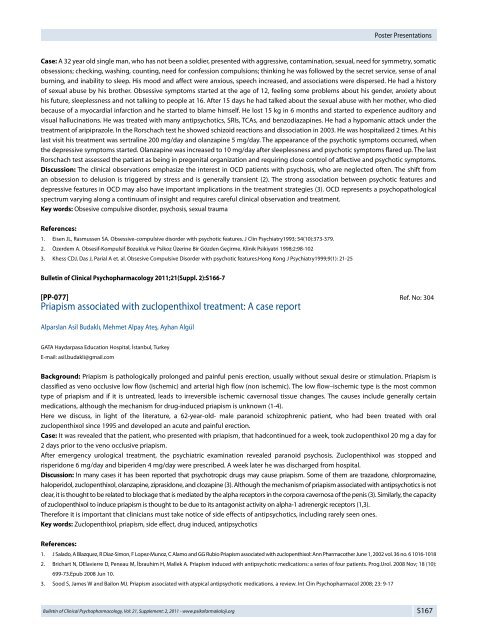SYMPOSIA
SYMPOSIA
SYMPOSIA
Create successful ePaper yourself
Turn your PDF publications into a flip-book with our unique Google optimized e-Paper software.
Bulletin of Clinical Psychopharmacology, Vol: 21, Supplement: 2, 2011 - www.psikofarmakoloji.org<br />
Poster Presentations<br />
Case: A 32 year old single man, who has not been a soldier, presented with aggressive, contamination, sexual, need for symmetry, somatic<br />
obsessions; checking, washing, counting, need for confession compulsions; thinking he was followed by the secret service, sense of anal<br />
burning, and inability to sleep. His mood and affect were anxious, speech increased, and associations were dispersed. He had a history<br />
of sexual abuse by his brother. Obsessive symptoms started at the age of 12, feeling some problems about his gender, anxiety about<br />
his future, sleeplessness and not talking to people at 16. After 15 days he had talked about the sexual abuse with her mother, who died<br />
because of a myocardial infarction and he started to blame himself. He lost 15 kg in 6 months and started to experience auditory and<br />
visual hallucinations. He was treated with many antipsychotics, SRIs, TCAs, and benzodiazapines. He had a hypomanic attack under the<br />
treatment of aripiprazole. In the Rorschach test he showed schizoid reactions and dissociation in 2003. He was hospitalized 2 times. At his<br />
last visit his treatment was sertraline 200 mg/day and olanzapine 5 mg/day. The appearance of the psychotic symptoms occurred, when<br />
the depressive symptoms started. Olanzapine was increased to 10 mg/day after sleeplessness and psychotic symptoms flared up. The last<br />
Rorschach test assessed the patient as being in pregenital organization and requiring close control of affective and psychotic symptoms.<br />
Discussion: The clinical observations emphasize the interest in OCD patients with psychosis, who are neglected often. The shift from<br />
an obsession to delusion is triggered by stress and is generally transient (2). The strong association between psychotic features and<br />
depressive features in OCD may also have important implications in the treatment strategies (3). OCD represents a psychopathological<br />
spectrum varying along a continuum of insight and requires careful clinical observation and treatment.<br />
Key words: Obsesive compulsive disorder, psychosis, sexual trauma<br />
References:<br />
1. Eisen JL, Rasmussen SA. Obsessive-compulsive disorder with psychotic features. J Clin Psychiatry1993; 54(10):373-379.<br />
2. Özerdem A. Obsesif-Kompulsif Bozukluk ve Psikoz Üzerine Bir Gözden Geçirme. Klinik Psikiyatri 1998;2:98-102<br />
3. Khess CDJ, Das J, Parial A et. al. Obsesive Compulsive Disorder with psychotic features.Hong Kong J Psychiatry1999;9(1): 21-25<br />
Bulletin of Clinical Psychopharmacology 2011;21(Suppl. 2):S166-7<br />
[PP-077] Ref. No: 304<br />
Priapism associated with zuclopenthixol treatment: A case report<br />
Alparslan Asil Budaklı, Mehmet Alpay Ateş, Ayhan Algül<br />
GATA Haydarpasa Education Hospital, İstanbul, Turkey<br />
E-mail: asil.budakli@gmail.com<br />
Background: Priapism is pathologically prolonged and painful penis erection, usually without sexual desire or stimulation. Priapism is<br />
classified as veno occlusive low flow (ischemic) and arterial high flow (non ischemic). The low flow–ischemic type is the most common<br />
type of priapism and if it is untreated, leads to irreversible ischemic cavernosal tissue changes. The causes include generally certain<br />
medications, although the mechanism for drug-induced priapism is unknown (1-4).<br />
Here we discuss, in light of the literature, a 62-year-old- male paranoid schizophrenic patient, who had been treated with oral<br />
zuclopenthixol since 1995 and developed an acute and painful erection.<br />
Case: It was revealed that the patient, who presented with priapism, that hadcontinued for a week, took zuclopenthixol 20 mg a day for<br />
2 days prior to the veno occlusive priapism.<br />
After emergency urological treatment, the psychiatric examination revealed paranoid psychosis. Zuclopenthixol was stopped and<br />
risperidone 6 mg/day and biperiden 4 mg/day were prescribed. A week later he was discharged from hospital.<br />
Discussion: In many cases it has been reported that psychotropic drugs may cause priapism. Some of them are trazadone, chlorpromazine,<br />
haloperidol, zuclopenthixol, olanzapine, ziprasidone, and clozapine (3). Although the mechanism of priapism associated with antipsychotics is not<br />
clear, it is thought to be related to blockage that is mediated by the alpha receptors in the corpora cavernosa of the penis (3). Similarly, the capacity<br />
of zuclopenthixol to induce priapism is thought to be due to its antagonist activity on alpha-1 adrenergic receptors (1,3).<br />
Therefore it is important that clinicians must take notice of side effects of antipsychotics, including rarely seen ones.<br />
Key words: Zuclopenthixol, priapism, side effect, drug induced, antipsychotics<br />
References:<br />
1. J Salado, A Blazquez, R Diaz-Simon, F Lopez-Munoz, C Alamo and GG Rubio Priapism associated with zuclopenthixol: Ann Pharmacother June 1, 2002 vol. 36 no. 6 1016-1018<br />
2. Brichart N, DElavierre D, Peneau M, İbrauhim H, Mallek A. Priapism induced with antipsychotic medications: a series of four patients. Prog.Urol. 2008 Nov; 18 (10):<br />
699-73.Epub 2008 Jun 10.<br />
3. Sood S, James W and Bailon MJ. Priapism associated with atypical antipsychotic medications. a review. Int Clin Psychopharmacol 2008; 23: 9-17<br />
S167



